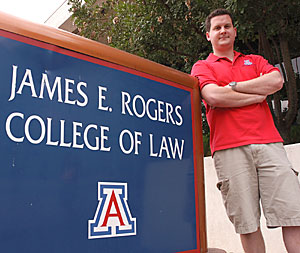 |
|
WILL SEBERGER/Arizona Daily Wildcat
|
Ben Graff, a second-year law student, is taking an active role in making sure a student representative will be part of a workgroup charged with studying the proposed restructuring of the state university system.
|
|
|
By Mitra Taj
Arizona Daily Wildcat
Tuesday, August 24, 2004
Print this
Students could have a louder voice regarding changes to the university system proposed this summer.
Gary Stuart, president of the Arizona Board of Regents, said he's interested in expanding a workgroup that will be guiding the proposed restructuring of the state's university system to include students.
"This is all about the students in the first place," he said. "It's all about student success."
But whether or not that will happen is still up in the air.
Regardless of whether a student will join the workgroup as a permanent member, student regents and student leaders said they're committing themselves to voicing students' concerns at meetings of the workgroup that lacks a single student representative.
Nonvoting student regent and second-year law student Ben Graff said he and voting student regent Wes McCally agreed earlier this month that at least one of them would be present for each meeting the workgroup holds.
"This has been a legitimate concern from the beginning of the process," said Graff. "I believe this is a perfect solution to that."
Workgroup meetings are open to the public and anyone can speak briefly during a call to the audience. But Graff and McCally wanted to participate in a feasibility study that will research higher education in Arizona and make recommendations to the board of regents.
The board of regents will make the final decision about the future of the university system.
Regent Chris Herstam pioneered the proposal and is the only regent on the workgroup.
After a "cordial discussion" and some "back and forth" with Herstam, Graff said the Herstam agreed the student regents could participate in workgroup activities.
"The (redesign) proposal has the potential to change the student experience," said ASUA President Alistair Chapman in June, after Herstam and the university presidents announced the plan.
The proposal would establish a system where three regional universities would help the state absorb future population growth.
"We would like students be included on the core workgroup," Chapman said then.
But later, when regents announced the members of the workgroup, students weren't included. University administrators were.
The original plan was criticized for potentially creating an "elitist" system that could exclude many future students from research-focused ASU and UA and redirect them to regional universities.
Since then, 15 alternative proposals have been submitted to the board.
Chapman said he's satisfied now that the student regents will join the redesign team.
But adding a student to the group is still a possibility. Stuart said he had students in mind when he asked Herstam whether or not it was too late to add people to the workgroup at the regents meeting Friday.
Herstam said it wasn't. "We're still very flexible," he said.
Stuart said two students have been contacting him about adding a student to the workgroup and that other regents have also heard students' repeated requests for more representation.
But in conversations yesterday, Herstam said he didn't think including a student in the workgroup was necessary, especially in light of the student regent's plan of participating in all meetings.
Herstam said he's also gotten many calls from student leaders wanting representation.
"There have been many requests from many fine people, but the workgroup is already very large," Herstam said. "We have no desire to expand the workgroup, unless there is someone that can bring a specific expertise to it."
Earlier this summer, Herstam and the other Regents agreed to expand the workgroup to include community college representatives after they complained a stakeholder group would not be enough to address their interests.
Mary Jo Waits, staff director of the feasibility study, said there was never any discussion about placing a student on the workgroup.
Waits and Herstam said including students in one of eight stakeholder groups will allow students to voice their concerns.
The stakeholder groups will give input two to four times during the year long study while the workgroup will meet monthly.
"There will be ample opportunity for the stakeholder groups to provide as much direct input as they want," he said.
Herstam said student regents have the option of attending workgroup meetings at any time. "That's why two student regents are appointed," he said.
But Stuart said a student regent's position doesn't differ much from that of a non-student regent and that they shouldn't be expected to only represent students' concerns.
"I don't think the student regents represent only students," Stuart said. "They vote the same as any other regent votes, and not necessarily on behalf of students."
Herstam said the decision to add more members to the workgroup will be his and Stuart's.
Though Graff said he and McCally will dedicate themselves to speaking up on issues that matter to students, he said a permanent student representative on the workgroup would be a positive thing.
"We absolutely support a student being labeled as a permanent member of the group," Graff said.
Chapman said the process of choosing just one person to represent all students in the state could be problematic.
"But both Wes and Ben have already been charged to represent all students," he said. "They were initially nominated by students and then were selected by a panel charged to represent all students."
Regent Ernest Calderon said he expected at least one student to be on the panel and ideally, students would be fundamental to the redesign study.
"In a perfect world, students would be a very important part of the workgroup," he said. "It would be nice to have at least a student on the panel."
